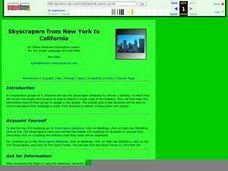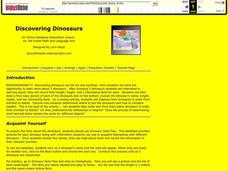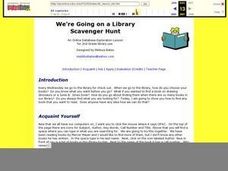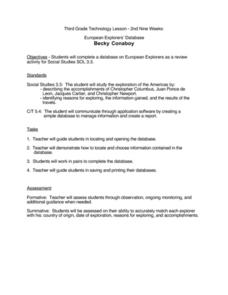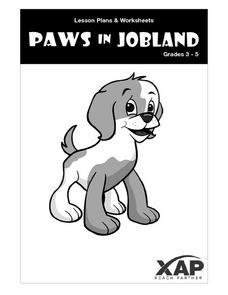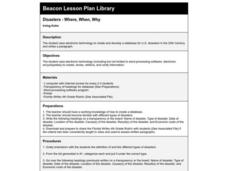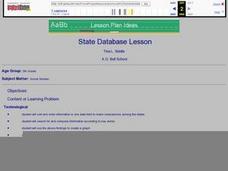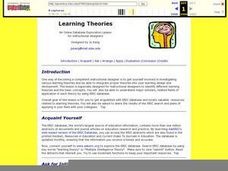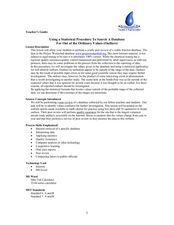Curated OER
Mammals
Pupils gather information from an online database about mammals. Choosing one mammal, they compare its physical characteristics, food habits, behavior and location to the other mammals they were introduced to in this instructional...
Curated OER
Skyscrapers from New York to California
Third graders use an online database to gather information on skyscrapers. Using the information, they choose one building and record its height and location. In groups, they design a city skyline including the skyscraper they choose....
Curated OER
Discovering Dinosaurs
Third graders use an online database to gather information about five dinosaurs that are of interest to them. Using a chart, they record their length, height and two interesting facts for each dinosaur. They draw a picture of the...
Curated OER
Dinosaur Database
Third graders practice using a database to find information related to dinosaurs. Using the data, they make informational cards to use while developing a timeline that shows when dinosaurs roamed the Earth. They answer comprehension...
Curated OER
Birds - Beaks and Feet
Second graders use an online database to research information about bird's beaks and feet. Using that information, they discover what foods they eat and where they live. In groups, they cluster the food/habitat and beak/feet data to make...
Curated OER
We're Going on a Library Scavenger Hunt
Second graders participate in a library scavenger hunt. Using a database, they practice typing in words to search for as they look for a book. They complete a worksheet with instructions to finish the scavenger hunt. To end the lesson,...
Curated OER
How Are Plants Similar And Different?
Studetns create an index card database of different categories of plants such as bushes, trees, flowers, grasses and vegetables. They review the different parts of a plant and label pictures of plants on the database cards. They use the...
Curated OER
Doughnuts to $ Database
Fifth graders are selling Krispy Kreme doughnuts to raise money for their overnight camping trip. They use a database to set to keep track of and record additions to their daily sales. Students then follow the step by step directions to...
Curated OER
Student Census
Students collect data from their peers and store the information in a database. As students manage the information they realize the usefulness of a database as a tool to manage large amounts of information in an efficient and accurate...
Curated OER
Technology Integration
Third graders describe and locate the five geographical regions of the state of Virginia. Using that information, they organize the descriptions in a database they created. They are graded based on accuracy and spelling all noted on a...
Curated OER
European Explorers Database
Third graders watch a demonstration on how to create a new database. In pairs, they enter information about European explorers in an easy to read fashion. They save and print their databases to be used in a review game before their test.
Curated OER
Graphically Speaking
Learners discover the links between population and Congressional representation. In this government lesson, students research population statistics and create spreadsheets that compare population to the number of Congress members per state.
Curated OER
Paws in Jobland: Role Play
Students think and talk about the world of work. In this career lesson plan, students communicate effectively with other students and work as part of a team to become familiar with database exploration.
Curated OER
For the Record: Black Inventors and Inventions
Learners research the Internet for information about African-American inventors and their inventions. After collecting their data, students must build and manage information in a database that catalogs the inventions of African-Americans.
Curated OER
For The Record
Learners create a database that catalogs their music collection of CD's and tapes. They sort, analyze and print selected database records in answer to questions about their favorite music recordings and performing artists. Each student...
Curated OER
Burning It Up
Students explore energy as it relates to body function. Data about the personal physical activity of students is gathered and entered into a database which is utilized to test hypotheses made.
Curated OER
Disasters - Where, When, Why
Fourth graders research natural disasters that have occurred in the US in the twentieth century. They create computer based database and use the information to write a paragraph.
Curated OER
State Database Lesson
Fifth graders create a database about the geography of the United States. The access to a computer is essential for this lesson. The outcome is that technology is used as a tool to measure student understanding of geographical locations....
Curated OER
Database in Social Studies
Fourth graders search a database for information on North Carolina lighthouses and Old Mills. Using their research, 4th graders generate further questions on these subjects and then research the answers.
Curated OER
Learning Theories
Students access the ERIC database and search for the resources on learning theories. They use the features of ERIC to bookmark sources and then use Excel to create a summary of the database search.
Curated OER
Research Paper
Ninth graders continue to work on their research papers including to credit and cite all resources used, incorporate a style manual, electronic databases, online resources as well as a Works Cited page. In addition, they orally present...
Curated OER
Make Your Own Database
In this database instructional activity, students follow directions on how to make their own database. Students complete 3 steps total.
Curated OER
Using a Statistical Procedure To Search A Database For Out of the Ordinary Values
Students develop a spreadsheet containing formulas and find summaries for them. In this investigative lesson students choose a topic, investigate it and use MS Excel to sort data.
Curated OER
Design Team Challenge
Young scholars work in groups to build a robot. In this robotics lesson plan, students create an electronic robot and program it to follow directions. They create an obstacle course for the robot to follow and test its performance.



